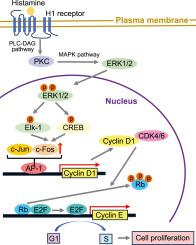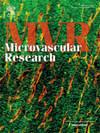组胺通过组胺H1受体-细胞外调节蛋白激酶1/2-cyclin D1/cyclin依赖性激酶4/6轴诱导血管内皮细胞增殖。
IF 2.7
4区 医学
Q2 PERIPHERAL VASCULAR DISEASE
引用次数: 0
摘要
组胺是一种生物胺,在生理创伤愈合和正常及肿瘤细胞增殖的炎症期起重要作用。组胺H1受体的刺激诱导血管内皮细胞增殖,可能在伤口愈合和癌症发展过程中促进血管生成。然而,参与血管生成的具体信号通路仍不清楚。基于我们之前的报道,组胺通过H1受体增加血管内皮生长因子和基质金属蛋白酶水平,诱导内皮细胞形成管,本研究旨在进一步研究组胺诱导血管内皮细胞增殖的EA.hy926。组胺通过H1受体通过蛋白激酶C途径磷酸化细胞外调节蛋白激酶1/2,并通过磷酸化Elk-1和cre结合蛋白增加C - fos表达。此外,c-Fos形成激活蛋白1,进一步上调cyclin D1的表达。Cyclin D1与Cyclin依赖性激酶4/6形成复合物,磷酸化Rb,使与Rb结合的转录因子E2F与Rb分离,诱导S期起始的重要因子提前细胞周期。总的来说,我们在这项研究中发现,利用组胺识别内皮细胞中H1受体介导的细胞增殖信号,有助于开发伤口愈合和癌症治疗的新策略。本文章由计算机程序翻译,如有差异,请以英文原文为准。

Histamine induces vascular endothelial cell proliferation via the histamine H1 receptor–extracellular regulated protein kinase 1/2–cyclin D1/cyclin-dependent kinase 4/6 axis
Histamine is a biogenic amine that plays important roles in the inflammatory phase of physiological wound healing and proliferation of normal and tumor cells. Stimulation of the histamine H1 receptor induces vascular endothelial cell proliferation, possibly contributing to angiogenesis during wound healing and cancer development. However, the specific signaling pathways involved in angiogenesis remain unclear. Based on our previous report that histamine induces endothelial cell tube formation by increasing the vascular endothelial growth factor and matrix metalloproteinase levels via the H1 receptor, we aimed to further examine histamine-induced cell proliferation using EA.hy926 vascular endothelial cells in this study. Histamine phosphorylated extracellular regulated protein kinase-1/2 through the protein kinase C pathway via the H1 receptor and increased c-Fos expression via phosphorylation of Elk-1 and CRE-binding protein. Moreover, c-Fos formed activator protein-1, which further upregulated cyclin D1 expression. Cyclin D1 formed a complex with cyclin-dependent kinase-4/6 and phosphorylated Rb, causing the transcription factor E2F, which is bound to Rb, to dissociate from Rb and induce the factors important for S phase initiation that advance the cell cycle. Overall, our findings in this study to identify H1 receptor-mediated cell proliferation signals in endothelial cells using histamine can aid in the development of new strategies for wound healing and cancer treatment.
求助全文
通过发布文献求助,成功后即可免费获取论文全文。
去求助
来源期刊

Microvascular research
医学-外周血管病
CiteScore
6.00
自引率
3.20%
发文量
158
审稿时长
43 days
期刊介绍:
Microvascular Research is dedicated to the dissemination of fundamental information related to the microvascular field. Full-length articles presenting the results of original research and brief communications are featured.
Research Areas include:
• Angiogenesis
• Biochemistry
• Bioengineering
• Biomathematics
• Biophysics
• Cancer
• Circulatory homeostasis
• Comparative physiology
• Drug delivery
• Neuropharmacology
• Microvascular pathology
• Rheology
• Tissue Engineering.
 求助内容:
求助内容: 应助结果提醒方式:
应助结果提醒方式:


